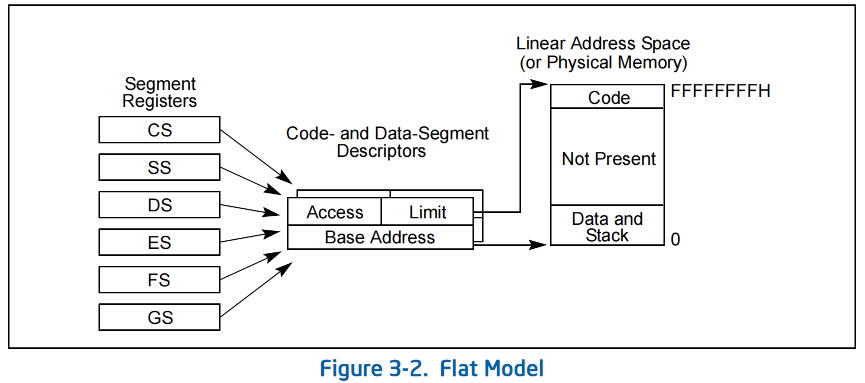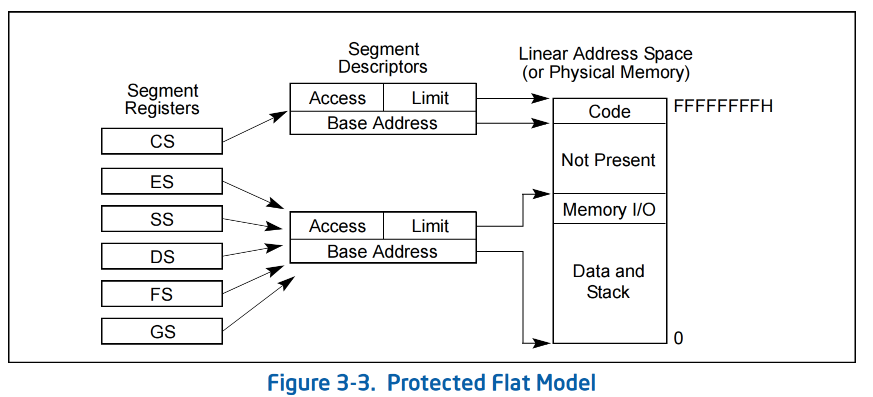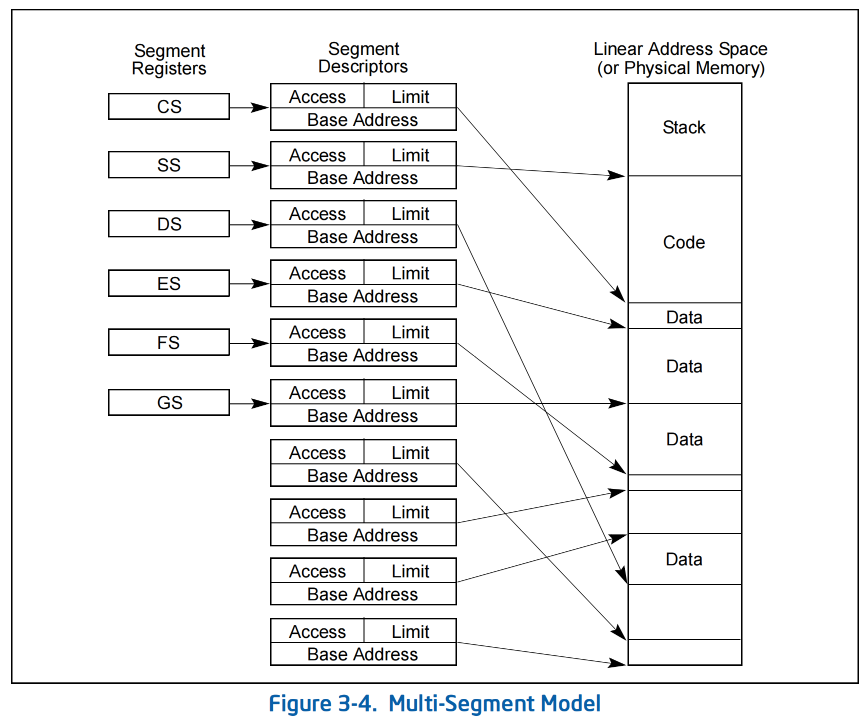Segmentation 2 -- usage
The segmentation mechanism supported by the IA-32 architecture can be used to implement a wide variety of
system designs. These designs range from flat models that make only minimal use of segmentation to protect



programs to multi-segmented models that employ segmentation to create a robust operating environment in
which multiple programs and tasks can be executed reliably.
Basic Flat Model
The simplest memory model for a system is the basic “flat model,” in which the operating system and application
programs have access to a continuous, unsegmented address space. To the greatest extent possible, this basic flat model hides the segmentation mechanism of the architecture from both the system designer and the application programmer.
To implement a basic flat memory model with the IA-32 architecture, at least two segment descriptors must be
created, one for referencing a code segment and one for referencing a data segment (see Figure 3-2). Both of
these segments, however, are mapped to the entire linear address space: that is, both segment descriptors have
the same base address value of 0 and the same segment limit of 4 GBytes. By setting the segment limit to 4
GBytes, the segmentation mechanism is kept from generating exceptions for out of limit memory references, even if no physical memory resides at a particular address. ROM (EPROM) is generally located at the top of the physical address space, because the processor begins execution at FFFF_FFF0H. RAM (DRAM) is placed at the bottom of the address space because the initial base address for the DS data segment after reset initialization is 0.

Protected Flat Model
The protected flat model is similar to the basic flat model, except the segment limits are set to include only the
range of addresses for which physical memory actually exists (see Figure 3-3). A general-protection exception
(#GP) is then generated on any attempt to access nonexistent memory. This model provides a minimum level of
hardware protection against some kinds of program bugs.

More complexity can be added to this protected flat model to provide more protection. For example, for the paging mechanism to provide isolation between user and supervisor code and data, four segments need to be defined: code and data segments at privilege level 3 for the user, and code and data segments at privilege level 0 for the supervisor. Usually these segments all overlay each other and start at address 0 in the linear address space. This flat segmentation model along with a simple paging structure can protect the operating system from applications, and by adding a separate paging structure for each task or process, it can also protect applications from each other. Similar designs are used by several popular multitasking operating systems.
Multi-Segment Model
A multi-segment model (such as the one shown in Figure 3-4) uses the full capabilities of the segmentation mechanism to provide hardware enforced protection of code, data structures, and programs and tasks. Here, each program (or task) is given its own table of segment descriptors and its own segments. The segments can be completely private to their assigned programs or shared among programs. Access to all segments and to the
execution environments of individual programs running on the system is controlled by hardware.

Access checks can be used to protect not only against referencing an address outside the limit of a segment, but also against performing disallowed operations in certain segments. For example, since code segments are designated as read-only segments, hardware can be used to prevent writes into code segments. The access rights information created for segments can also be used to set up protection rings or levels. Protection levels can be used to protect operating-system procedures from unauthorized access by application programs.
Segmentation in IA-32e Mode
In IA-32e mode of Intel 64 architecture, the effects of segmentation depend on whether the processor is running in compatibility mode or 64-bit mode.
In compatibility mode, segmentation functions just as it does using legacy 16-bit or 32-bit protected mode semantics.
In 64-bit mode, segmentation is generally (but not completely) disabled, creating a flat 64-bit linear-address
space. The processor treats the segment base of CS, DS, ES, SS as zero, creating a linear address that is equal to the effective address. The FS and GS segments are exceptions. These segment registers (which hold the segment base) can be used as additional base registers in linear address calculations. They facilitate addressing local data and certain operating system data structures.
Note that the processor does not perform segment limit checks at runtime in 64-bit mode.



